More and more companies are using AI in employee engagement to improve impact. It’s a challenge to get it right. We’ve got you covered.

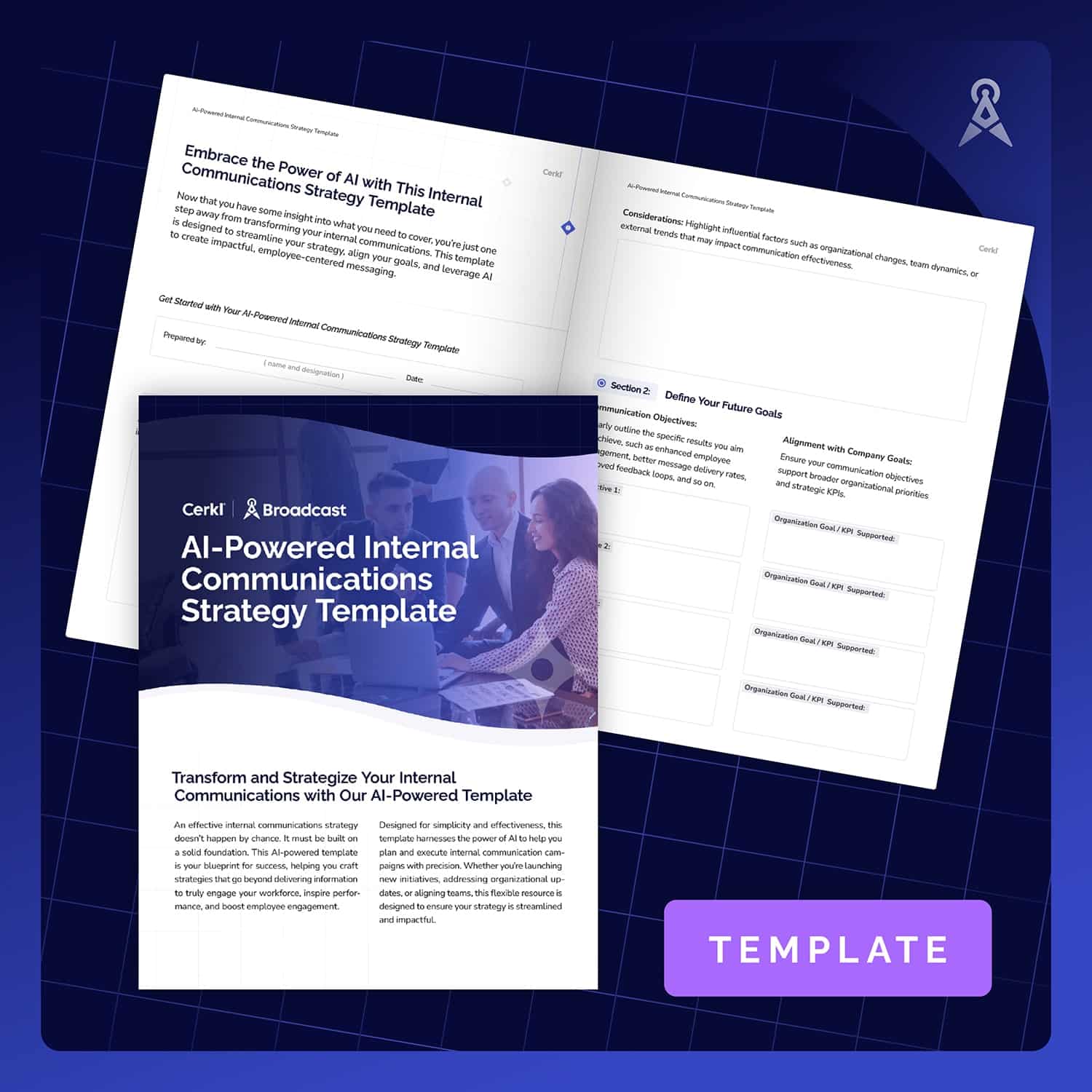
Start strategizing smarter. Download your free AI-driven internal communications strategy template now!
Access NowKeeping a workforce engaged is a huge challenge — especially when it is a global workforce. Companies that get it right are generally innovative, forward-thinking, and driven to succeed. They identify the importance of employee engagement and the role it plays in enhanced employee performance and productivity.
In the past few years, an increasing number of organizations have started using artificial intelligence or AI in employee engagement, with remarkable results.
Many have learned that AI streamlines tasks, accelerates talent acquisition, fosters engagement, and reduces turnover, offering a superior employee experience. As long ago as 2019, a Society for Human Resources Management (SHRM) study showed that a staggering 88% of organizations globally leverage AI in HR. However, this statistic doesn’t seem to be shifting.
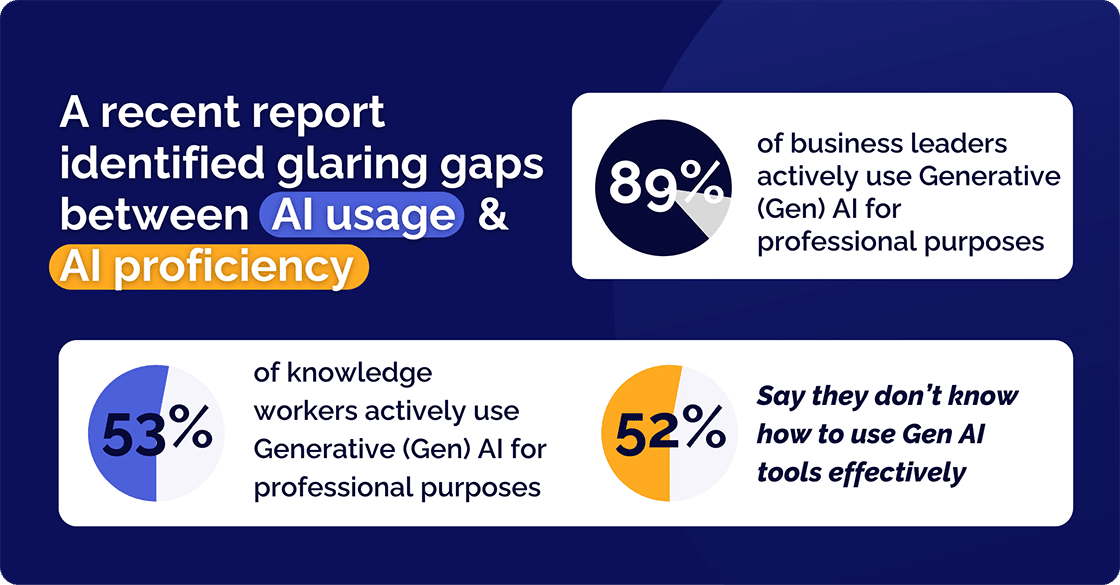
Grammarly’s 2024 State of Business Communication report, which focuses on the potential of artificial intelligence to turn overload into impact, identifies glaring gaps between AI usage and AI proficiency. For example, 89% of business leaders actively use Generative (Gen) AI for professional purposes, while only 53% of knowledge workers do. Of these 53%, 52% say they don’t know how to use Gen AI tools effectively. The greatest success seems to lie in professionals using Gen AI for writing tasks, with 72% stating they use it for business communication.
The report reveals two sides of the story:
In its 2024 Employee Experience Trends Report, Qualtrics reveals that the more engaged employees are, the more open they are to using AI at work. According to Sarah Marss, Qualtrics director of EX Strategy Execution, an engaged employee who has a positive experience will recognize that AI is enhancing the experience. But, if employees lack trust, they will blame AI for increasing the poor behavior and decisions they think they have seen.
The report states that 53% of engaged employees say they’re comfortable with AI at work, versus 30% of disengaged employees. Further, 65% of the C-suite reported being comfortable with AI, versus 46% of managers.
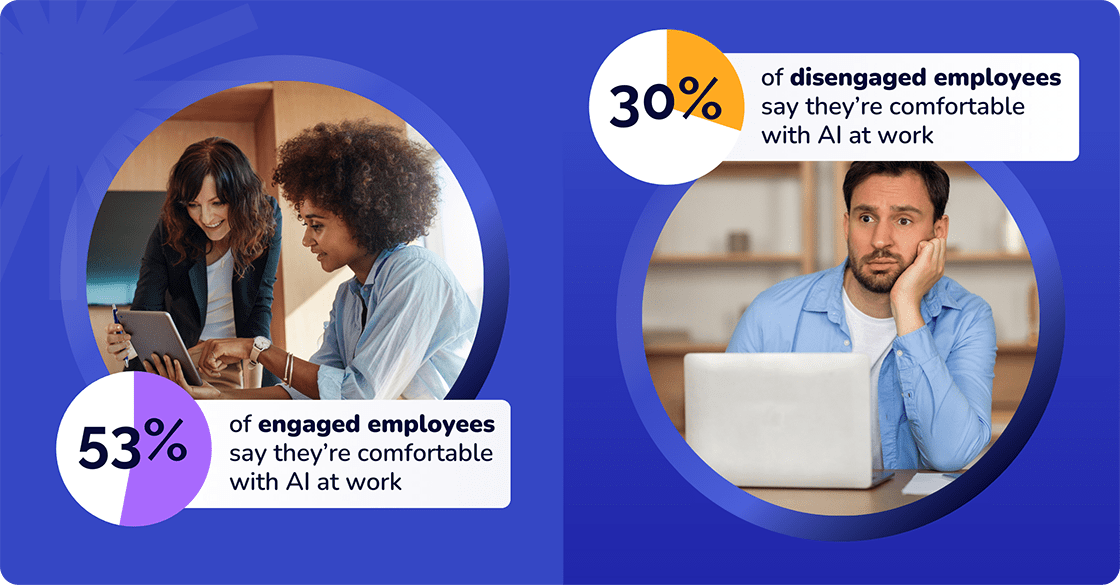
“Generally, the more positive you feel about your organization – the more trust you have in it – and the more senior your role, the more likely you are to believe that your organization will use AI for your benefit. You also trust that AI will make you more productive and efficient at your job.”
Sarah Marrs
AI and employee engagement are connected through various mechanisms:
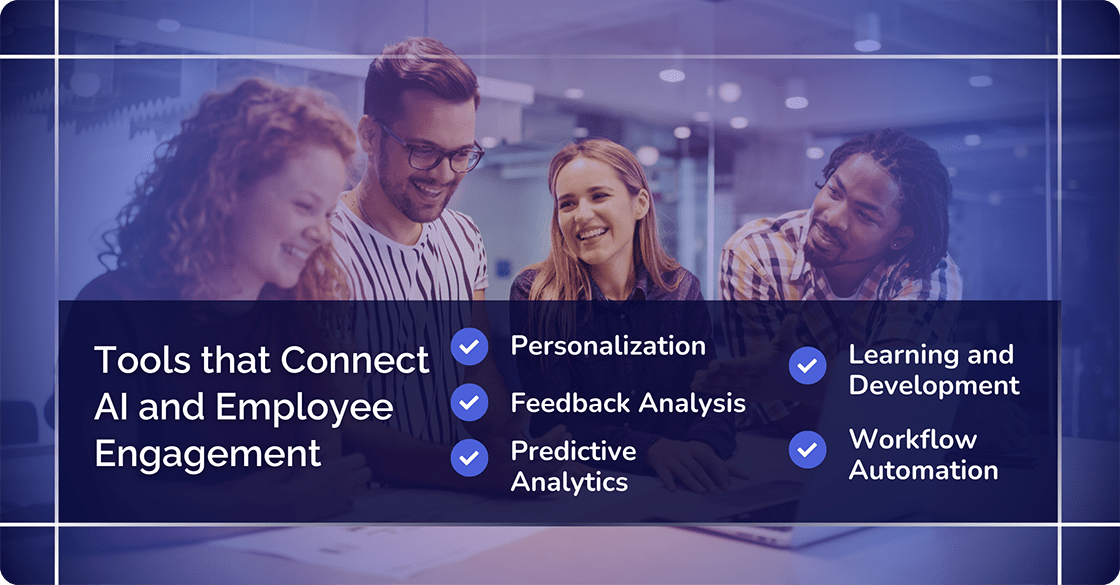
Ultimately, artificial intelligence empowers organizations to understand, connect with, and empower their employees in ways that improve and enhance their engagement, satisfaction, and productivity.
During 2024, Tarel Kamil, the founder and CEO of Cerkl Inc., was a speaker at the 11th Annual Strategic Internal Communications – West, hosted by the Advanced Learning Institute (ALI). Held in San Francisco, it is ranked as the #1 top-rated conference for internal communicators.
Tarek’s talk, A.I. Saved Our Inboxes (and we couldn’t be happier) focused on the experience that California State University (CSU), Stanislaus has had since they started using Broadcast in 2018. It tracked what their internal communications — which were originally primarily one-off emails — were like between 1957 and 2017 and how they have evolved after implementing Broadcast.
Looking back at the traditional approach CSU Stanislaus followed before 2018, it’s easy to see its severe limitations. Apart from the fact that they were limited to one-off emails, inbox stuffing was a major audience pain. Also, there were no analytics and no ability to schedule emails. There were no design “guardrails” in the form of messages built outside the tool and forwarded. Commonly, there were accessibility issues as well.
These are, in essence, typical limitations organizations faced — and sometimes still face — when they use (or like CSU Stanislaus used) traditional approaches to employee engagement.
After implementing Cerkl Broadcast in 2018, CSU Stanislaus identified these impacts that continue today:
The image below shows how Cerkl technology changed the way they approached internal communications. This, in turn, enabled them to change their approach to employee engagement.
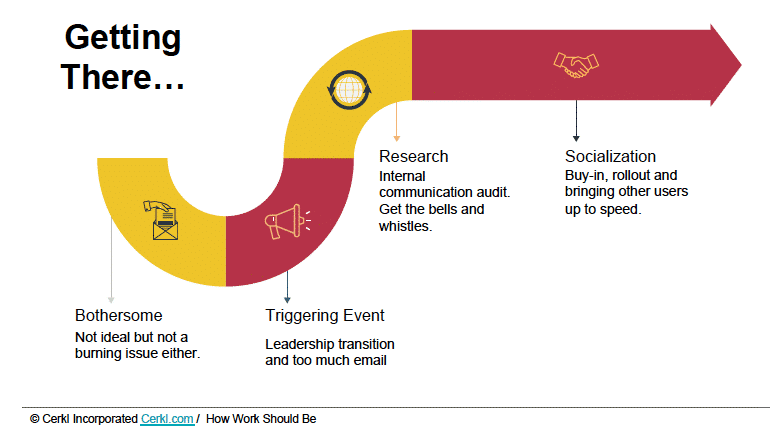
Those attending the conference learned how CSU Stanislaus benefited. This is how work should be, and Cerkl Broadcast will help you ensure it works for you too:
Harness the power of AI to devise a strategy that will be a game-changer for your organization.
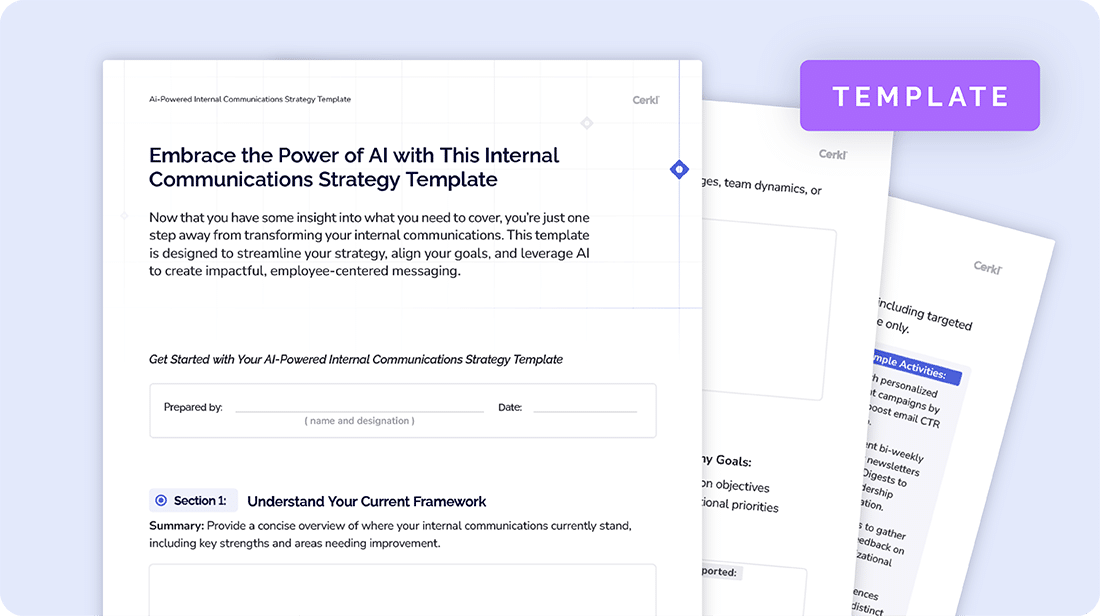
AI has the potential to be a powerful driver of employee engagement, but only when used intentionally. Rather than seeing AI as a standalone solution, organizations should view it as a set of tools that support people-centered strategies. The key is to apply AI in ways that strengthen transparency, trust, and connection.
In Striking AI Gold for Internal Communications & Employee Engagement, Bill Bain, head of communications at Arch Calderon Inc. in New York urges organizations to look ahead responsibly. He cautions that transparency, fairness, and a healthy respect for privacy need to underpin every AI application. This, he says, will ensure that while technology improves communication, it does it ethically and mindfully, prioritizing employee well-being and trust.
“Maintaining ethical standards in leveraging AI tools is imperative as teams navigate this transformative journey.” Bill Bain
With that in mind, here are six ethical, practical strategies to use AI in your employee engagement efforts. Each contributes to the core engagement goals explored here:
Keep employees informed without overwhelming them. AI-powered content curation tools can analyze individual preferences, job roles, and behaviors to deliver personalized news digests or intranet content. These systems ensure that each employee receives relevant updates while avoiding information overload.
By delivering tailored communication, organizations can increase message relevance, reduce digital fatigue, and make employees feel more connected to company priorities. This type of personalization improves not only engagement but also communication effectiveness.
Imagine having an AI assistant available 24/7 to answer employee questions, guide these through HR processes, and offer instant support, freeing up HR teams for strategic initiatives. Today, it’s a reality that empowers employees with faster resolutions, fostering a sense of accessibility and responsiveness, leading to higher engagement.
If you don’t provide employees with real-time feedback they can easily become disillusioned, thinking management doesn’t care about their input.
AI can analyze data and provide regular, objective feedback on performance and areas for improvement, promoting a culture of continuous learning. Personalized recognition based on data reinforces positive behavior and motivates employees to contribute their best work, boosting morale, engagement, and employee satisfaction.
Automated performance management eliminates tedious performance reviews with AI-powered systems that track progress, identify strengths and weaknesses, and suggest development opportunities. This frees up managers’ time for coaching and mentoring while empowering employees with data-driven insights for growth. It also fosters employee engagement.
AI can tailor learning paths and resources based on individual strengths, weaknesses, and interests. This empowers employees to pursue personal and professional development, fueling a sense of ownership and purpose.
Additionally, adaptive learning platforms leverage AI to adjust content and pace to each learner, maximizing engagement and knowledge retention.
AI can analyze data to identify potential burnout, stress, or disengagement before these issues escalate. This allows for proactive intervention through targeted support or well-being resources. By prioritizing employee well-being, AI helps to create a positive and supportive work environment, fostering loyalty and long-term engagement.
Harness the power of AI to devise a strategy that will be a game-changer for your organization.

Core strategies for successfully using AI in employee engagement to provide personalized learning and development opportunities, automate tasks to free up employees' time, and analyze data to gain insights into employee sentiment and needs. AI-powered systems can also track employee performance, provide personalized feedback, and even predict potential issues like disengagement, allowing for proactive interventions.
Here’s a more detailed look at how artificial intelligence is transforming employee engagement.
AI algorithms can analyze individual employee data such as performance history, interests, and learning styles, which can create tailored development plans. This personalized approach makes training more relevant and engaging, improving knowledge retention and skill growth.
Virtual AI coaches can support employees in setting goals, navigating career paths, and overcoming challenges, helping them envision a future within the organization. This kind of personalized guidance increases motivation and fosters a sense of purpose.
Additionally, AI can offer regular, unbiased feedback based on performance data, supporting a culture of continuous learning and improvement. This reduces the risk of human bias and helps employees feel fairly assessed and supported.
AI enhances internal communications by powering smart tools that manage meeting logistics, offer real-time language translation, and analyze tone or sentiment in chats and emails. Chatbots and virtual assistants can answer employee questions, handle administrative tasks, and provide instant support, helping to break down communication barriers and promote inclusivity.
AI-powered chatbots and virtual assistants can instantly respond to employee questions or handle basic tasks, increasing accessibility and responsiveness. At a team level, AI can analyze collaboration patterns and recommend optimal team compositions based on complementary skills and personalities, fostering better team dynamics and a sense of belonging.
AI excels at handling repetitive, time-consuming administrative tasks such as data entry, scheduling, or summarizing text. This frees up employees so they can focus on more meaningful, strategic work.
This shift not only boosts productivity but also empowers employees to use their strengths and creativity, leading to higher job satisfaction. Choosing the right AI tools for specific functions including communication and database management, or communications, can ensure the most effective results.
AI can process large volumes of employee data from sources including surveys, feedback platforms, and performance metrics to uncover patterns and trends. These insights enable internal communicators, HR leaders, and organizations as a whole to better understand employee sentiment and fine-tune their engagement strategies.
Crucially, AI can also detect early signs of disengagement, burnout, or cultural issues, enabling HR teams and managers to take timely, proactive measures before problems escalate.
With AI, performance management becomes more continuous and individualized. Automated tracking systems provide real-time feedback together with suggestions for growth, helping employees and managers align goals and expectations.
AI can also identify and reward achievements using objective data, ensuring fair recognition across the organization. To make recognition more engaging, some companies use animation software to create dynamic certificates or celebratory videos. This inevitably adds a creative, personal touch to appreciation efforts.
Additionally, AI tools can recommend wellness initiatives, flexible work arrangements, or personalized support resources, reinforcing an organization’s commitment to employee well-being and empowerment.
Repetitive tasks are boring, but AI can handle many of these efficiently, including routine data entry, scheduling, and summarizing text. Just be sure to choose an AI model that is designed for the task or tasks that are important to you — an AI database editor or a summarizer tool, for instance.
Ultimately, by using AI, companies can free up employees’ time for more creative and strategic work. This reduces burnout and allows employees to focus on their strengths, leading to increased satisfaction and engagement.
AI-powered apps can suggest flexible work arrangements, childcare options, or wellness resources. It demonstrates concern for staff well-being and empowers them to manage their work-life balance effectively, leading to higher employee engagement.
Remarkably, AI can identify and reward individual and team achievements based on objective data matches. This personalized recognition reinforces positive behavior and motivates employees to contribute their best work, improving employee performance.
To further enhance the recognition process, animation software can be used to create visually engaging rewards, such as animated certificates or celebratory videos, that acknowledge individual and team accomplishments.

Cerkl has been empowering organizations through Broadcast, its AI-powered platform since 2018, all the while constantly improving the software to enhance employee engagement. You’ve seen how Broadcast has enabled CSU Stanislaus.
Another company that Cerkl has empowered is St. Elizabeth Healthcare. Headquartered in Kentucky, it incorporates six hospitals operating through southeastern Indiana and northern Kentucky, as well as specialty and primary care facilities throughout Kentucky, Ohio, and Indiana. Communicators were attracted by Cerkl Broadcast’s ability to personalize internal communications. More specifically, they identified the advantages of improving employee engagement using AI-powered email and intranet personalization.
Prior to joining forces with Cerkl, St. Elizabeth communicators relied on PDF documents attached to emails. They couldn’t measure engagement in terms of numbers let alone individuals. Communications manager Chad Schwalbach recognized the importance of their audience and wanted to overcome the challenges of making sure the right people received the right comms at the right time.
Describing how segmentation and personalization make it so much easier for internal communicators to deliver effective messaging, Chad Schwalbach says it’s quick and easy, and helps us to deliver specific information to specific people.“
“Our communications are getting through. We’re breaking through to the people that we need to reach.” Chad Schwalback
Challenges that St. Elizabeth Healthcare faced before implementing Cerkl Broadcast included engaging a dispersed workforce, creating unified comms for diverse teams, and personalizing newsletter content for employees.
Chad and his team had to guess what employees wanted to know about. Furthermore, some employees wanted to receive newsletters on Fridays, at the end of the week Others preferred to get content first thing on a Monday morning. And there was no way to measure engagement.
“We didn’t know who was clicking on what. It simply wasn’t effective communication.” Chad Schwalback
Using Audience Manager, St. Elizabeth was able to implement segmentation, targeting employees on one hand and medical staff and physicians on the other. Cerkl’s Insights gave the content team a complete overview of staffers’ interests, down to each subscriber, enabling personalization. Cerkl tells St. Elizabeth what topics interest staff, what content performs well, and who is becoming more or less engaged — all because they are using AI in employee engagement.
Switching to Cerkl Broadcast gave Chad and his team more insight than they’d ever had before. After publishing about 6,500 pieces of content, they could identify a 54% open rate for employees and a 46% open rate for medical staff.
Once they had access to data behind their communications, St. Elizabeth was able to tailor new content and give people the information they really wanted. They could get a better sense of employee engagement issues, including what they were interested in and how frequently they were accessing content.
Beyond the statistics, they could see that using AI was improving employee engagement and helping to develop a stronger company culture.
“The biggest thing we’ve noticed since implementing Cerkl Broadcast is that our readership, our clicks, and our opens are all up. And they’re all above national averages. Not only is it satisfying to know that we’re reaching people, we’re giving them information that engages them, and it makes it easier to go up the chain." Chad Schwalback
Cerkl Broadcast enables you to introduce AI in employee engagement. Our AI-powered platform delivers personalized emails and intranet content to engage and inform employees. That’s a great start. But we can also help you to transform and strategize your internal comms with our AI-powered template. It’s easy to use and designed for organizations to customize it to their specific needs and take it to the next level.
Tailor our free template to cater to the unique needs and communication goals of your organization. It’s a great way to streamline your strategies and ensure that your internal communications will drive measurable impact.
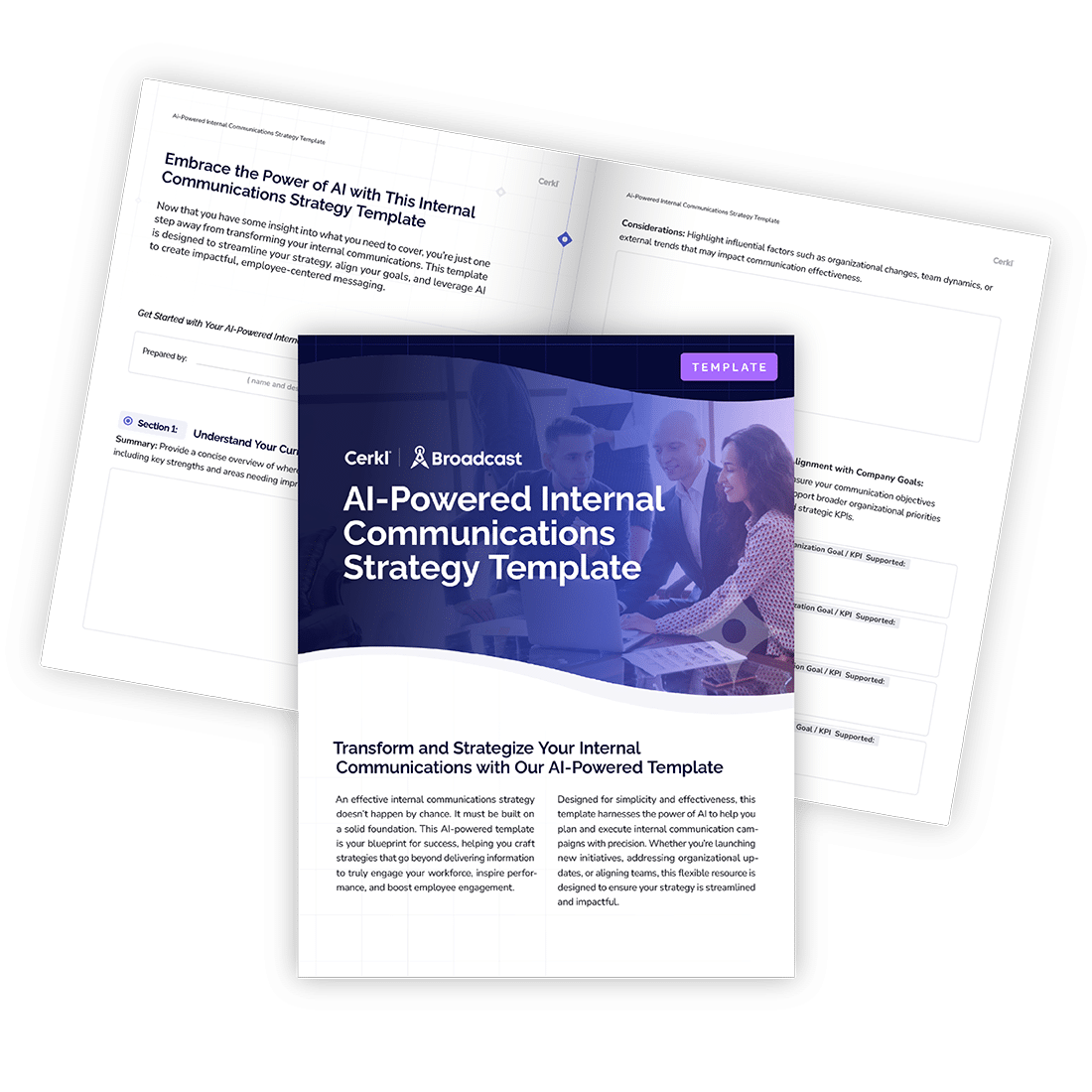
Harness the power of AI to devise a strategy that will be a game-changer for your organization.
How is AI used in employee engagement? AI is commonly used in employee engagement to personalize experiences through learning, career coaching, and feedback. It uses sentiment analysis to understand the emotional tone behind written words and predictive analytics to identify factors affecting engagement. This is particularly useful to accurately review feedback and assess employee satisfaction. It also boosts efficiency by automating tasks and using work-life balance tools.
How can AI be used in employment? AI can be used in employment for tasks such as resume screening, candidate sourcing, skills matching, and automating administrative HR processes. It is also very useful for applying adaptive learning paths during training to ultimately improve employee performance.
How is AI beneficial to employees? AI benefits employees by streamlining repetitive tasks, providing personalized learning and development opportunities, and enhancing job satisfaction through improved work-life balance and reduced workload. It also empowers employees with efficient tools and improves communication and collaboration.

Harness the power of AI to devise a strategy that will be a game-changer for your organization.